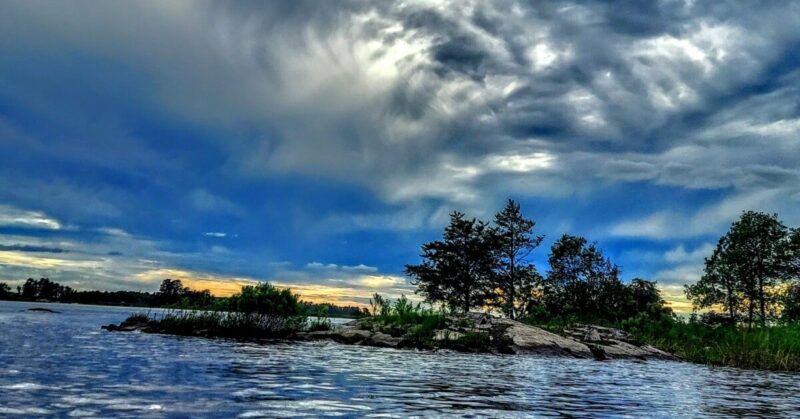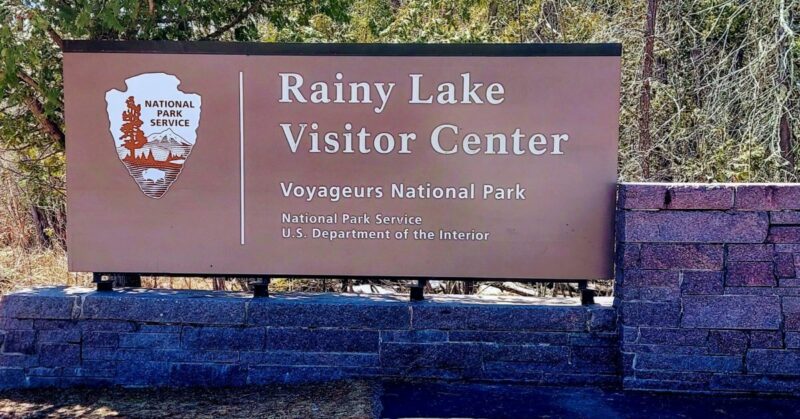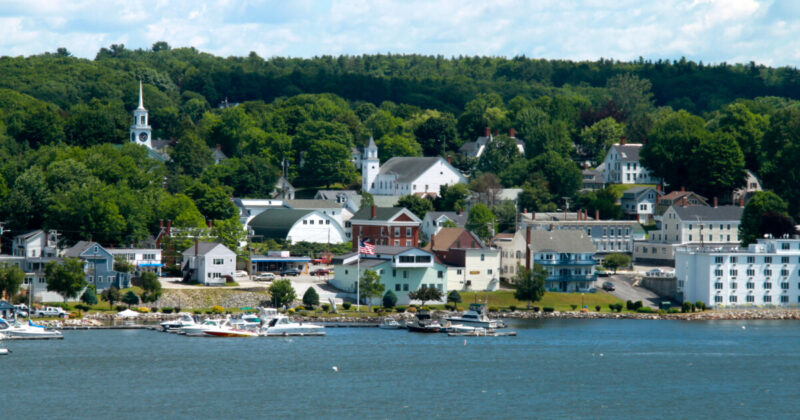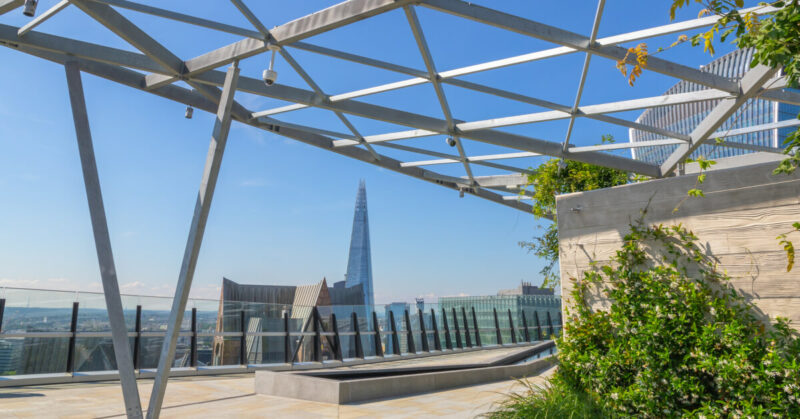We may earn a commission if you buy through some of the links on this page, at no cost to you. Advertising policy
Voyageurs National Park in northern Minnesota is a gorgeous and amazing place, but it’s not a typical national park in many ways. More than 40% of the park comprises four huge lakes, with a large, remote peninsula making up the bulk of the rest. Naturally, many visitors have questions about the park and the best way to visit it.
This guide to the most important things to know when visiting Voyageurs National Park addresses the most common questions and misconceptions about this gem of America’s national park system. We hope it helps you to get the most out of your trip to this stunning and incredible place.
- More Voyageurs National Park Guides
1. Can you drive through Voyageurs National Park?
You can’t drive through Voyageurs National Park. Unlike some national parks, Voyageurs National Park doesn’t have a main road that visitors can drive or bike to see the main features and attractions, although there are three visitor centers that can be accessed by car. The primary access to Voyageurs is via motorized boat, canoe, or kayak launched from one of the many boat ramps available in the park or the surrounding area – except in winter, when the the Rainy Lake and Kabetogama Lake Ice Roads open, allowing winter visitors to drive their vehicles across parts of the frozen lakes.
The winding, 3-mile park road known as Meadwood Road leading to the Ash River Visitor Center is the closest thing you’ll find at Voyageurs National Park to a typical national park scenic road. There are three overlooks and several trailheads along this road. To reach it, travel east on Ash River Trail (County Road 129) from the intersection with Minnesota State Highway 53. Turn north on Meadwood Road at the Voyageurs National Park sign.
Voyageurs has ten hiking trails that are accessible by car and five trails that are accessible by boat. Most hikes are short, although some take a few hours to complete. The only land-based backcountry, backpacking opportunity in Voyageurs is along the Kab-Ash trail, which has four trailheads and features two primitive campsites.
2. Do you need a boat to camp at Voyageurs National Park?
Camping at Voyageurs National Park requires a boat – and reservations.
The sheer granite cliffs, boreal and hardwood forest, and lakes of Voyageurs National Park are an ideal setting for a fun and memorable camping trip. There are more than 150 lakeside and 2 trailside sites – some of the lake sites include your own island. If you plan to camp in Voyageurs, you’ll need to make reservations online or by phone with recreation.gov – you can’t make camping reservations directly with the park. Lake campsites are accessible by boat only.
Voyageurs offers three types of campsites: 147 front country sites which can be reached directly by boat; 14 backcountry sites which require that campers boat to a trail, then hike to the campsite; and 2 primitive sites along the Kab-Ash hiking trail, which are the only campsites in the park that can be accessed without a boat.
The front country camp sites in Voyageurs National Park are located on the park’s four main lakes. The backcountry sites are all on the Kabetogama Peninsula. If reaching a backcountry site requires crossing an interior lake on the peninsula, the park provides a canoe along the trail for this purpose.
3. Does Voyageurs National Park rent canoes, kayaks, or other boats?
Voyageurs National park does not rent canoes, kayaks, or other boats.
People with reservations to camp in Voyageurs National Park sometimes show up at one of the visitor centers with their camping gear expecting to be able to rent a canoe or kayak there, only to be disappointed when they learn that’s not actually a service offered by the park. There are, however, local businesses where visitors can rent a boat or arrange for a water taxi to take them to their campsite.
If you plan to camp at Voyageurs and need a boat or a ride to your site, make sure to reserve one as soon as you’ve completed the campsite reservation, especially during the busy season of June through mid-September.
Although Voyageurs National Park does not rent boats, it does offer guided boat tours of the park. The park also provides canoes needed to reach certain backcountry campsites, such as those on or near some of the smaller lakes located within the Kabetogama Peninsula.
4. If you’re paddling to a campsite, make sure the trip is within your limits.
Voyageurs National Park is home to gorgeous lake views, fantastic sunsets, the eerie calls of loons and wolves, and some of the best fishing in the world. One of the best ways to experience the park’s beauty, and to really immerse yourself in it, is to boat to one of its campsites and spend the night. Who knows, maybe you’ll even be lucky enough to catch the northern lights from a front-row, lakeside seat.
Camping at Voyageurs is definitely worth the effort, but no one wants their perfect trip marred by an emergency or any sort of dangerous situation. When paddling to a campsite, or really anywhere within Voyageurs National Park, it’s important to know your limits.
The first thing to be aware of is that most front country and backcountry campsites in Voyageurs NP require that you navigate across or around multiple channels, bays, and islands. You’ll also have to cross fairly wide sections of one or more of the four big lakes.
Paddling across large channels is almost always more challenging than paddling along the shore. Wind, waves, and wake from motorized boats can affect not only the stability of your watercraft, but the speed at which you’re able to paddle it. If you don’t know how to deal with these factors, you could find yourself in trouble very quickly. With that being said, it’s important to keep some perspective.
- You should have no problems paddling to your Voyageurs National Park campsite if you:
- are a paddler with a medium level of experience
- have a partner with a low to medium level of experience, if tandem
- avoid paddling in winds of 20 mph or higher
- know what to do if occasional medium to large waves come your way, from wind gusts, motorized boat wake, or both
- have the right gear, including safety devices like whistles, dry bags, and PFDs
- have reserved a campsite that is within your physical limits to reach
Another crucial thing to keep in mind is that some of the campsites are really far from the nearest boat launch – think 20 miles or more. Tandem canoes can only travel about 2-4 miles per hour depending on conditions, with hard-sided kayaks a little faster – but these speeds require near-constant paddling, which is difficult for most people to do for more than a few hours at a time. This effectively means that the farther camp sites are beyond the range of most paddlers, at least to reach in a single day.
Paddling to a campsite in Voyageurs National Park and hanging out there for a few nights – or even one, if that’s all you’ve got – is an extremely rewarding experience. To enjoy it to the fullest, choose your campsite wisely. Make sure you know where the closest boat launch is located, how far the campsite is from the launch, and that you have the experience, knowledge, and equipment to reach your site, camp there, and return safely.
5. Make sure to allow enough time to see the park.
Because lakes comprise so much of Voyageurs National Park, with most of its land area on the remote Kabetogama Peninsula, it takes a bit more time and effort to see a big chunk of it than other national parks. However, if you’re wondering how many days you need to spend at Voyageurs National Park to enjoy your visit, you’ll be glad to know you can thoroughly enjoy the park’s beauty in as little as half a day.
For ideas on things to see and do, check out our detailed guide to planning a visit to Voyageurs National Park. It has half day, full day, and multi-day itinerary suggestions, with activities appropriate for a variety of interests, skill levels, and abilities.
6. What gear do you need to camp at Voyageurs National Park?
Along with your tent, sleeping bag, camp stove, and the basic gear you need to camp in Voyageurs National Park, there are a couple special items that you should strongly consider taking along with you as well. Bugs in the park have been known to ruin many a trip; we’ll explain our economical, DEET-free system for keeping them away. We’ll also show you some crucial gear to help make your canoe / kayak trip and your time in camp drier and more comfortable.
Insect repellents: Minnesotans joke that their state bird is the mosquito. There are over 50 species of the the bloodsuckers in the state and you’ll find many of them at Voyageurs National Park. Although most of them aren’t harmful to humans, the ones that are can turn an enjoyable camping trip into a downright awful experience. In addition to mosquitoes, ticks, which may spread tularemia or other diseases, are common in Minnesota forests.
As if the mosquitoes and ticks aren’t bad enough, we’ve also found the black flies to be obnoxious during trips to Voyageurs, particularly as we paddle on the lakes.
So is there anything you can do to protect yourself from thousands of tiny, 6-legged attacks on you and your campsite? Yes! With a little prep and planning, you can easily avoid having these pests ruin your fun and adventure. Here are the products we use and recommend to keep the bugs away, and how best to deploy them:
1. Thermacell Portable Mosquito Repeller – this handy device is quite effective at keeping mosquitoes away. It runs off a butane cell, which heats a small mat containing insect repellent. It doesn’t need batteries or other power source, it’s odor-free, and there’s no open flame or spray of liquid to worry about.
Keep it with you and use it around camp; it’s especially useful when getting into and out of your tent. Set it in the vestibule or just inside / outside the door.
2. Sawyer insect repellent – safe and effective, this combo pack has a large container (permethrin) for treating for clothing and gear, and a smaller personal use spray bottle (picaridin). Before you go, treat your tent, clothes, and pet bedding with the permethrin, which lasts for 6 washes. It will repel mosquitoes and kill ticks and chiggers. Spray a small, hidden area on each item to make sure it won’t stain. Don’t use it on hats, underwear, or inner clothing.
Use the picaridin on your skin to repel mosquitoes, ticks, chiggers, gnats, biting flies, no-see-ums, and other biting insects. This stuff works great but rinses off, so if you’re in and out of the water you have to keep re-applying it.
3. PIC lantern and bug zapper – use the small but mighty LED lantern to light your tent, and the built-in bug zapper for any itinerant intruders that managed to sneak in. We usually leave it on overnight. Runs on 3 AA batteries; take extra batteries if going for multiple nights. Does it work? We used on our last trip – here’s a picture, you can judge for yourself:
4. Mintronella incense sticks – light these sticks, place them around the perimeter of your camp and watch the insects disappear. When camping at Voyageurs, we use only 3 or 4 at a time to great effect. Safe and all-natural, these sticks use lemongrass, citronella, and peppermint oil instead of harsh chemicals.
Use these with the Thermacell repeller when getting into and out of your tent to keep the interior bug-free.
5. Face mesh – face mesh is great for when you don’t want to spread or spray chemicals on your face, but you also don’t want to get eaten alive by insects. Cheap, safe, and effective.
Dry bags: Even on calm days, water invariably gets inside a canoe or kayak. If you’re paddling to a campsite, you definitely don’t want to deal with wet gear. For front country campsites in Voyageurs, we use and recommend the SealLine Discovery dry bag. It’s durable, inexpensive, completely waterproof if loaded and sealed correctly, and it floats for hours on end if something unfortunate should happen.
We also use and love the FE Active waterproof cooler backpack. It kept our food cold for almost 36 hours in sunny, 85 degree weather – including 2 hours in the straight sun as we canoed to the site. At around $60 or so, it’s really a great value.
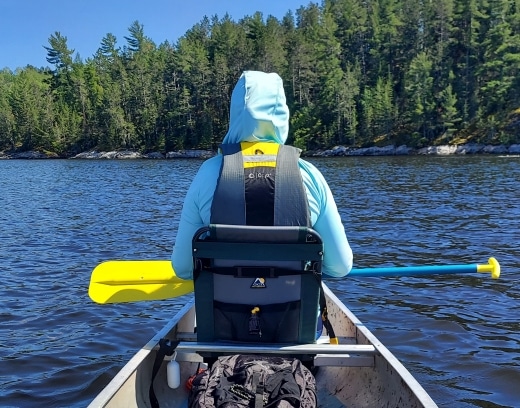
Canoe seat / camp chair: metal or mesh canoe seats are hard, uncomfortable, and have no back support whatsoever. If you plan to rent a canoe to camp in the park, $50 for a canoe chair may seem like too big an investment. The improvement in comfort you will experience is, in our opinion, well worth the price.
Whether you own a canoe or plan to rent one, consider adding this GCI outdoors chair to your gear. It’s durable, adjustable, comfortable, supportive, and collapses so you can sling it over your arm for carrying. As an added bonus, the seats double as very comfortable camp chairs, perfect for use at a picnic table, around camp, or, as we discovered, fishing on the lakeshore or from the canoe.
The picture above shows the chair in action on Lake Kabetogama in Voyageurs National Park.
Water filter: If you need a water filter, you can’t go wrong with the Sawyer Squeeze water filtration system. We used it in Voyageurs National Park and it worked great. If you ‘ve got questions about drinking the water in the park, we’ve got answers here.
7. Are there bears in Voyageurs National Park?
There are more than 120 black bears in Voyageurs National Park, and like all predators, they have the potential to be dangerous.
The forests and waters of Voyageurs National Park offer opportunities for amazing backcountry and wilderness experiences, a key component of which are the more than 150 black bears that call the park and adjacent areas home. While injuries to humans from bears are rare, the park reports multiple bear-human interactions every summer, some of which can result in severe property damage. And don’t be fooled into thinking you can let your guard down because you have an island campsite. Bears can, and do, swim to islands in the park’s lakes – as do gray wolves.
- If you plan to camp during your visit to Voyageurs, you can help the park keep its resident bears and other wildlife, as well as its human visitors safe by:
- using the bear-proof lockers are each campsite to store food, utensils, clothes with food odors, and other items with odors (toothpaste, shampoo, soap, lotion, bug spray, etc.).
- hanging garbage high in a tree and taking it with you when you leave the campsite.
- knowing what to do when you encounter a bear.
8. Are pets allowed in Voyageurs National Park?
Pets are only allowed in certain areas of Voyageurs National Park.
Voyageurs National Park restricts the locations where dogs and other pets are allowed, including some campsites and most hiking trails. Where pets are allowed, they must be on a 6 foot leash and have the proper vaccinations as required by Koochiching and St. Louis Counties.
Visitor centers / parking lots: Dogs and other pets are allowed in the immediate vicinity of any visitor center or parking lot at Voyageurs National Park. One exception is at the Rainy Lake Visitor center, where pets aren’t allowed in the ethnobotanical garden area adjacent to the visitor center main building.
Campsites: Pets are allowed in all 147 frontcountry campsites at Voyageurs National Park, which are sites that directly accessible by boat. Pets are not allowed at backcountry campsites, all of which are on the Kabetogama Peninsula and require boating to a location, then backpacking the rest of the way to the site.
Hiking trails: The only hiking trail in Voyageurs National Park where dogs or other pets are allowed is the 1.7 mile Recreation Trail from the Rainy Lake Visitors Center to to the intersection of Koochiching County Hwy 98 and Minnesota State Hwy 11.
Pets are not allowed on the Anderson Bay Loop, Beaver Pond Overlook Trail, Black Bay Beaver Pond Trail, Blind Ash Bay Trail, Cruiser Lake Trail, Echo Bay Trail, Forest Overlook Trail, Kab-Ash Trail, Kabetogama Lake Overlook Trail, Locator Lake Trail, Mukooda Trail, Oberholtzer Trail, Sullivan Bay Trail, or Tilson Connector Trail.
Dog teams and sleds: Dog teams and sleds are allowed on frozen lake surfaces in the winter. Using an established snowmobile portage requires a special use permit.
9. When is the best time to see the northern lights?
Although Voyageurs National Park is one of the best places in the US to see the aurora borealis (AKA the northern lights) it’s actually much less common to see them during the summer months when solar wind activity is lower. Winter, primarily December through March, offers a much better chance of seeing this breathtaking light show.
With that being said, the aurora does show up every so often in the summer. To see the northern lights, you need darkness, a clear sky, and high enough solar wind activity. You can get notifications from various apps or websites alerting you when conditions are right to see this amazing phenomenon.
10. Can you drive to Kettle Falls Hotel?
You can’t drive (or paddle) to the Kettle Falls Hotel.
The historic Kettle Falls Hotel offers the only lodging or restaurant available in Voyageurs National Park. Built in 1913 and refurbished in 1987, the hotel is one of the few places in the United States where you can look south into Canada. There are no roads to Kettle Falls Hotel; you can only get there by boat or float plane, or snowmobile in winter.
There are only 12 guest rooms and 3 villas for rent at Kettle Falls Hotel, so you’ll need reservations before you go. The guest rooms have no bathrooms in them, so be prepared to use one of the shared facilities.
Due to its distance from the nearest boat launch, it’s not advisable to take a canoe or kayak to Kettle Falls Hotel, although both can be rented at the hotel once you arrive. It can also be fairly tricky to get to the hotel in a houseboat, which is why they’re not recommended, either.
If you’re going to motor across the lake to the hotel, the closest places to put in are the Ash River or Kabetogama Visitor Centers. The Rainy Lake Visitor Center, Voyageur’s most visited of the three in the park, is much farther away. The hotel offers a free water taxi for guests to and from the Ash River Visitor Center; you can request this service when you make your reservation.
11. Where are the waterfalls at International Falls and Kettle Falls?
There are no waterfalls at International Falls or Kettle Falls.
Places with “falls” in the name bring to mind a scene of steep, roaring rapids and sun-dappled spray. Unfortunately, if you’re looking to see the waterfalls that give International Falls and Kettle Falls their names, you’re out of luck, because they no longer exist, at least to the naked eye.
The city of International Falls, MN (“I-Falls” to locals) was named for a series of rapids that occur where Rainy Lake and the Rainy River meet. The “falls” are no longer visible after being flooded by the construction of a dam in 1909. They’re now located beneath Rainy Lake, under the International Bridge that connects International Falls, Minnesota and Fort Frances, Canada.
Kettle Falls, MN, formed by a 10-foot drop between Namakan Lake and Rainy Lake, was dammed in 1914 and no longer exists as a natural waterfall.
12. Can I camp in my RV at Voyageurs National Park?
You can’t camp in a motorhome, fifth wheel, or travel trailer in Voyageurs National Park. There are no campgrounds in the park, only dispersed campsites that require a boat for access. There are, however, some other great options for car, tent, and RV camping available nearby: Woodenfrog and Ash River campgrounds are located in nearby Kabetogama State Forest, City Beach campground is in Ranier / International Falls, and the Superior National Forest offers both developed and dispersed camping opportunities.
How to get to Voyageurs National Park
The closest city to Voyageurs National Park, and its primary gateway community, is International Falls, Minnesota. Fort Frances, Ontario is just across the Rainy River from International Falls. Other nearby towns include the smaller towns of Ash River, Kabetogama, Crane Lake, and Orr, all in Minnesota.
Where to fly into to visit Voyageurs National Park: Falls International Airport (INL) is located in International Falls, MN. Avis rental cars are available there. Fort Frances (YAG) in Canada has a smaller airport, with Enterprise rental cars available.
- Most flights connect from Minneapolis – St. Paul (MSP).
- Search flights to Minnesota on Expedia
- Search rental car availability at MSP
More facts about Voyageurs National Park
The most unusual thing about Voyageurs National Park is that it is largely a water-based park and requires a boat to see most of it. What makes Voyageurs special is the fact that it’s a unique mix of land, lakes, rivers, wetlands, developed areas, and remote wilderness.
Visiting Voyageurs National Park is free – the park does not charge entrance fees.
The lakes and rivers in Voyageurs National Park are a dark reddish brown color due to tannins that seep into the water from the park’s vegetation. While tannins may be aesthetically displeasing and impart an unpleasant taste, they aren’t harmful to humans or animals.
If properly filtered, you can drink water from Voyageur National Park’s lakes and rivers. We use and recommend the economical, lightweight, and versatile Sawyer Squeeze water filtration system.
We used the Sawyer filter on Rainy Lake and Kabetogama Lake in Voyageurs National Park. The filtered water was tinged slightly brown but tasted great. We did have to backflush it fairly frequently to keep it working smoothly, so make sure to reserve some clean water for that if using the Squeeze filter.
Temperatures in the 80s and above are common in Voyageurs National Park in the summer, enough to warm the lake water to comfortable swimming temperatures, especially near shore. Many of the park’s campsites feature private, sandy coves and small beaches. You can, and should, swim in Voyageurs National Park if you ever have the opportunity.
Although the international border area of Minnesota is prone to heavy, even torrential rainfall from time to time, Rainy Lake was named for the heavy mist that formed above the rapids where the lake flows into the Rainy River (also named for the mist).
The rapids, for which the city of International Falls, Minnesota (“I-Falls” to locals) is named, were flooded by the construction of a dam in the early 1900s and are no longer visible. The rapids or falls are located beneath the International Bridge connecting I-Falls and Fort Frances, Canada.
There is one sign in Voyageurs National Park that shows the park name without also displaying the name of a visitor center, but you’re going to need a boat to see it. The sign is located along the shore of Kabetogama Lake west of the Ash River Visitor Center, facing the lake.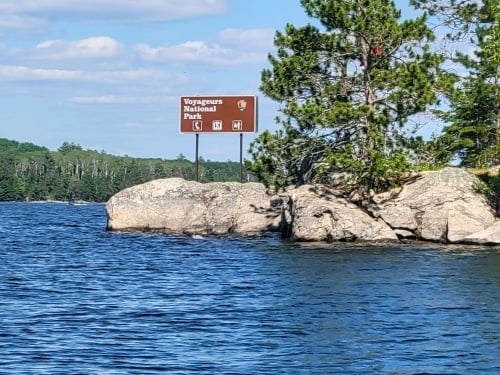
Opportunities for bicyclists in Voyageurs National Park are somewhat limited compared to other national parks. The only park trail that allows biking is the paved Rainy Lake Recreation Trail.
There’s also a popular bicycling route along Hwy 11 from International Falls to the Recreation Trail trailhead at the MN State Hwy 11 / County Hwy 96 intersection. Be aware that the route is a paved bike trail for part of the way, with other portions requiring that you pedal along the highway shoulder.
- More Voyageurs National Park Guides
Estimated reading time: 19 minutes

